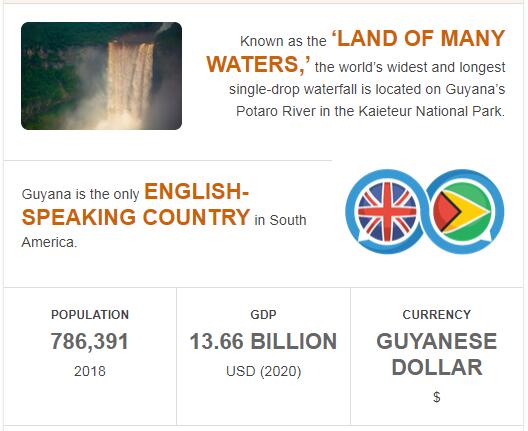The population of Guyana in 2017 was 786,552 people, with the majority living in urban areas. The economy of Guyana is largely based on services, industry, and agriculture, with a GDP of $4.2 billion and a relatively high per capita income. Guyana is a member of the United Nations, Caribbean Community (CARICOM), Organization of American States (OAS) and the Commonwealth. It has close ties to many countries throughout Latin America as well as its former British colonial masters. In terms of politics, it is a unitary presidential republic with President David A. Granger as its head of state. The Prime Minister is Moses Nagamootoo who leads the People’s National Congress party which has been in power since 2015. See militarynous for Guyana military and defense.
Yearbook 2017
Guyana. At the end of July, the US oil company ExxonMobil confirmed that new oil deposits had been discovered in the so-called Payare reservoir, part of the large Stabroek Block oil field about 130 nautical miles off the coast of Guyana. In total, the oil field could produce the equivalent of up to 3 billion barrels of oil as of 2020. As a result of the new discoveries, infrastructure worth $ 500 million needs to be built on the Berbice River. See ABBREVIATIONFINDER for frequently used acronyms and abbreviations related to as well as country profile of Guyana.
According to Countryaah.com, the Stabroek Bloc is located along the entire coast of Guyana, and the oil discovery in July brought to light the more than 100-year-old, infected border dispute with neighboring Venezuela over Essequibo, the eastern half of Guyana and off the coast of which the Stabroek bloc partially lies. The dispute with Venezuela has also affected the rights to oil in the area in question. In September, Guyana President David Granger argued before the UN General Assembly in New York that the border dispute should be resolved definitively by the International Court of Justice in The Hague (ICJ), something the Venezuelan government opposes. Observers noted that, from a historical perspective, Venezuela does not want a military solution to the conflict, but prefers to maintain the uncertainty about the status of the area by delaying the issue, while Guyana wants an international court ruling in its favor and that Essequibo is finally declared to be part of Guyana. The provocative tone between the United States and Venezuela suggests that the United States will unreservedly support Guiana’s rights in this context. The fact that the oil discovery in the Payares reservoir was made by ExxonMobil also made the issue extra difficult, since ExxonMobil’s assets in Venezuela were nationalized in 2007 and that the current US Secretary of State Rex Tillerson was both chairman and CEO of the company.

Guyana Geopolitical Atlas
Guyana, a state located north of the South American continent, traditionally enjoys strong ties with the countries of the Gulf of Mexico. Member of the Caribbean Community (Caricom) since its foundation in 1973, it hosts the headquarters of its Secretariat in Georgetown. Guyana has a semi-presidential institutional structure and a unicameral parliament elected for a five-year term. The internal political system is formally articulated in a bipartisan sense. In reality, however, the country is ethnically divided: 43.5% of the population is descended from Indian immigrants, while 30% has African origins. The parties perfectly reflect the ethnic bipartition, with the People’s National Congress (PNC) representing the residents of African origin and the People’s Progressive Party (PPP) which is instead an expression of the population of Indian origin. Considering the percentage distribution of ethnic groups, therefore, we understand why the PPP remained in power continuously between 1992 and 2015, the year in which the elections were won by the new Apnu-Afc coalition. The dominance of the PPP was the cause of serious political and social crises, especially during the pre and post-electoral periods and, even today, relations between the PPP and the NCP are characterized by extreme mistrust.
The most serious problems in the country concern the living conditions of the population. In Guyana, the process of poverty reduction has been at a standstill since 1990 and about a third of the population lives on less than a dollar a day. The country has one of the highest emigration rates in the world – over 40% of citizens live abroad – and, in the region, it is one of the largest recipients of remittances in relation to GDP. The haemorrhage of skilled workers (equal to 80% of the total emigration flow) deprives the country of professionals in key sectors, such as healthcare. The economic structure still revolves around agricultural production (in particular that of sugar, which however has fallen by 32.5% in recent years) and the mining industry (gold and bauxite).
The internal security problems are also relevant, with serious repercussions on the social level. Guyana is, first of all, one of the hubs of South American drug traffickers who, thanks to the country’s geographical position, have an outlet on the Atlantic. For this reason, the violence connected with drug trafficking has been combined with that of local criminal organizations and murders of a political nature. The country’s international relations are relatively stable today. Guyana collaborates with the US to combat drug trafficking, while the ancient territorial disputes have been overcome with Venezuela, especially since the Georgetown government became an observer member of the Bolivarian Alliance. Relations with Suriname have also improved, starting with the election as president of the latter country of Desiré Bouterse, which took place in 2010. On 11 July 2013, Suriname and Guyana signed an agreement to become associate members of Mercosur.